Sunday, 24 June, Maillol in the city, Foujita, and La Dame de Pic
Written 31 July 2018
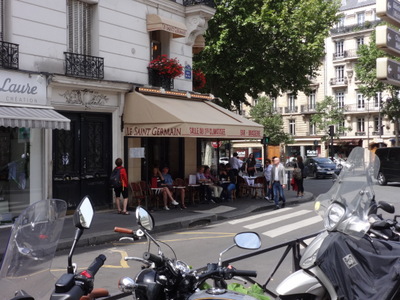
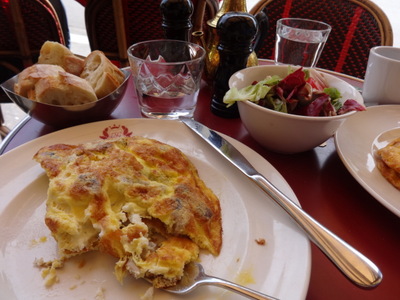 Lunch can be a problem on a Sunday in Paris, because so many places are closed. I did a little poking around on the web to verify that we had a couple of fallback positions if we couldn't find anything near our destination, then we set off bravely to visit the Musée Maillol on the left bank, which displays the work and celebrates the life of Aristide Maillol (1961–1944).
Lunch can be a problem on a Sunday in Paris, because so many places are closed. I did a little poking around on the web to verify that we had a couple of fallback positions if we couldn't find anything near our destination, then we set off bravely to visit the Musée Maillol on the left bank, which displays the work and celebrates the life of Aristide Maillol (1961–1944).
Fortunately, just a block or two away, we found Le Saint Germain open for business and settled in at one of their sidewalk tables. Our omelets were overcooked by the Progres's (and my) standards but palatable enough. They were served with the usual small salad and bread, and David's tea came in an elaborate brass pot.
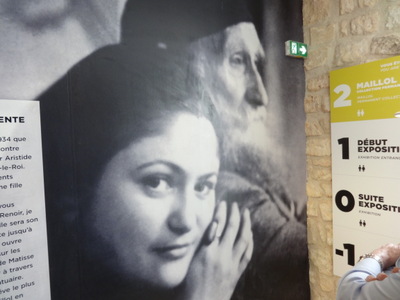
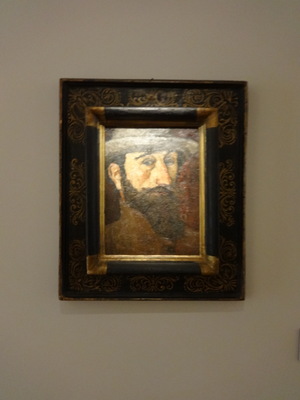 We like Maillol a lot, and we've already visited his country studio in Banyuls (https://www.bio.fsu.edu/~thistle/blog14/14-05-30.html), so today was dedicated to his Paris residence and studio.
We like Maillol a lot, and we've already visited his country studio in Banyuls (https://www.bio.fsu.edu/~thistle/blog14/14-05-30.html), so today was dedicated to his Paris residence and studio.
The photographic portrait at the left is of Maillol and his last model, Dina Vierny. She embodied his feminine ideal and is quoted as saying "je suis venue poser une heure, je suis restée dix ans" ("I came to pose for an hour; I stayed for 10 years"). At his death in 1944, he left everything to her, and she established a foundation dedicated to promoting his work. It owns and manages both the Paris and the Banyuls museums.
The image at the right is of a self-portrait by Maillol.
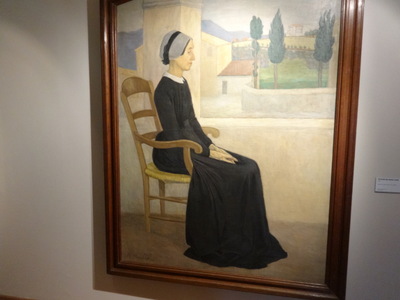
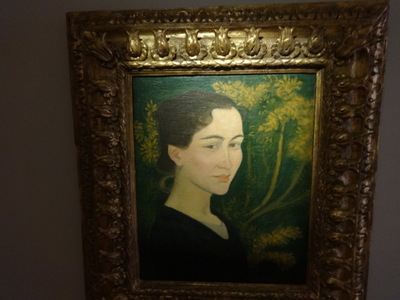 In his early years, Maillol experimented with painting. At the left is an 1892 "Portrait of Aunt Lucy." At the right is a an 1894 portrait of his wife. I can't say I'm especially taken with his style.
In his early years, Maillol experimented with painting. At the left is an 1892 "Portrait of Aunt Lucy." At the right is a an 1894 portrait of his wife. I can't say I'm especially taken with his style.
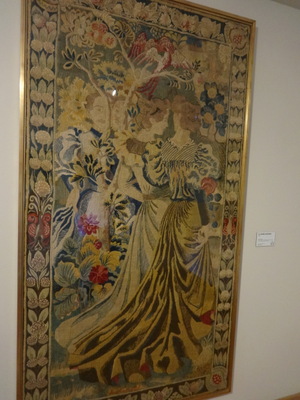
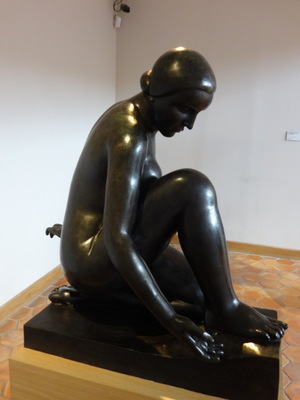 Maillol himself said that he never found his artistic fulfillment in painting but was much happier designing tapestries, like the one at the left here, entitled "The Enchanted Garden.
Maillol himself said that he never found his artistic fulfillment in painting but was much happier designing tapestries, like the one at the left here, entitled "The Enchanted Garden.
Fairly soon, though, he found his real love—modeling the robust, nude female form—and for the rest of his career never bothered to portray anything else. That poses a problem for me, as I've promised the platform that so graciously supports my on-line travel diaries not to display anything off-color. I therefore searched among the many, many works in the museum for one I could in good conscience show here (although I apparently wasn't quite as scrupulous in 2014, when I posted the page linked above). The image at the right is the only such view I could find. It's a back view of Maillol's monument to Debussy, and I'm told it's one of three Maillols displayed at the Metropolitan Opera in New York, so if you can't make it to Paris, maybe you can see it there.
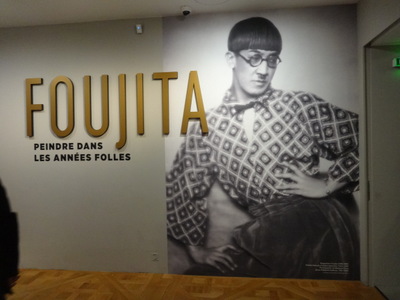
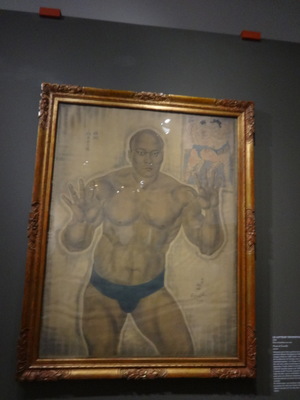 The museum was also hosting a temporary exhibition of the work of Tsugouharu Foujita (1886–1968), about which we knew nothing whatever, so we visited that as well.
The museum was also hosting a temporary exhibition of the work of Tsugouharu Foujita (1886–1968), about which we knew nothing whatever, so we visited that as well.
The image at the left is of the exhibitions introduction "Foujita: painting in the roaring 20's." He was born in Tokyo and spent his first 24 years in Japan, but after graduating from art school there he moved to France, which he'd long wanted to do. He lived in France for the rest of his life, except for visits back to Japan and an interlude in South America, where he was also very popular.
The painting at the right is "The Wrestler Tochigiyama" (1926), ink and painting on silk.
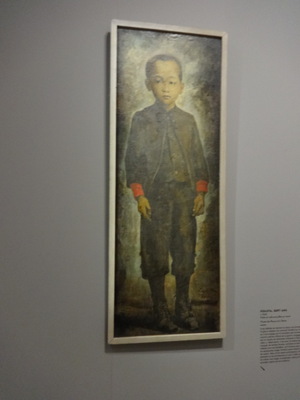
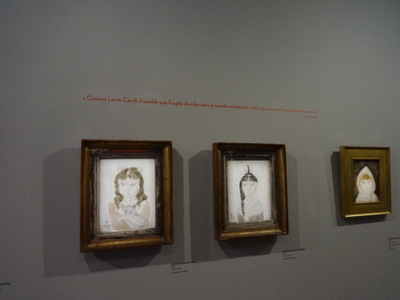 At the left here is a 1940 painting (when he was in his 50's) of himself at age 7.
At the left here is a 1940 painting (when he was in his 50's) of himself at age 7.
At the right are a few of a long series of drawings he made of little girls. Above them is a quote from Jean Cocteau saying (in my translation), "Like Lewis Caroll, it seems that Foujita seeks in the world of childhood the reflections that move grownups."
Foujita's own famous quote is (again, in my translation), "Not many artists find themselves passing for a French painter in the eyes of the Japonese but for a Japanese painter in the eyes of the French.
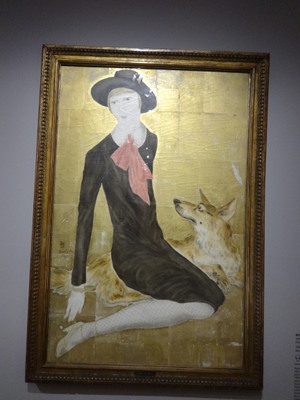
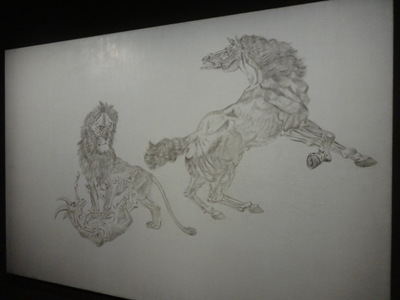 Here's his portrait of Suzy Solidor, socialite, independent woman, and sometime singer. Apparently, in those years, everybody had to paint Suzy's portrait—she insisted on it. In Cagnes in 2005, we visited a museum (in the Grimaldi palace) that displayed part of her own collection of portraits of her (though according to the label, she didn't actually commission this one herself).
Here's his portrait of Suzy Solidor, socialite, independent woman, and sometime singer. Apparently, in those years, everybody had to paint Suzy's portrait—she insisted on it. In Cagnes in 2005, we visited a museum (in the Grimaldi palace) that displayed part of her own collection of portraits of her (though according to the label, she didn't actually commission this one herself).
At the right are some studies for a larger work. The man could definitely draw when he wanted to. We also saw the larger work, but it definitely did not meet the criteria for display here.
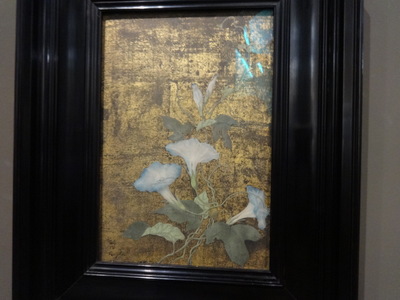
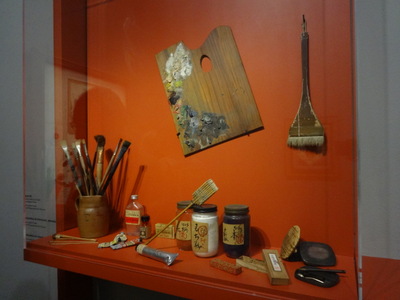 One of my favorites was this painting of "volubilis" (Ipomaea purpurea, morning glories; gouache and gold leaf on paper).
One of my favorites was this painting of "volubilis" (Ipomaea purpurea, morning glories; gouache and gold leaf on paper).
This exhibition concluded with this display case containing many of the tools and materials Foujita used in his studio. As is often the case, my images and descriptions convey only a poor impression of the richness of the exhibition, which included many, many more examples of his work, as well as a wealth of biographical information.
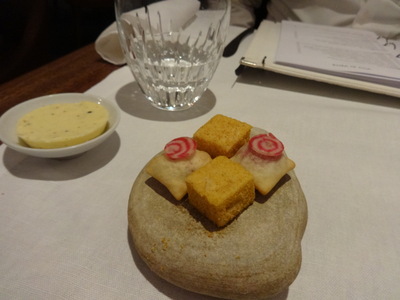
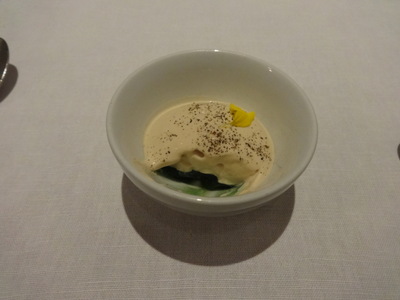 For Sunday dinner, David chose La Dame de Pic ("The Queen of Spades"), the restaurant of Anne-Sophie Pic, near the Palais Royal. More dratted "ladies' menus" without prices, as well as having to insist before they would speak French to me, but the food was good.
For Sunday dinner, David chose La Dame de Pic ("The Queen of Spades"), the restaurant of Anne-Sophie Pic, near the Palais Royal. More dratted "ladies' menus" without prices, as well as having to insist before they would speak French to me, but the food was good.
The amuse-bouche was served on a rock, which the waiter had some difficulty preventing it from falling off of. The tall squares were curry and peanut-flavored marshmallows, and the others were crispy little pillows made of bread dough topped with tiny radish slices and filled with a preparation of radish and coffee. David ate his before he realized it had coffee in it, but it doesn't seem to have done him any harm. You can also see the disk of butter, dotted with something dark that was never explained. Tasty, though.
Alas, I've forgotten what the second amuse-bouch was. It consisted of a bright green jelly topped with a pale creamy sauce and decorated with marigold petals. Whatever it was, we ate it up.
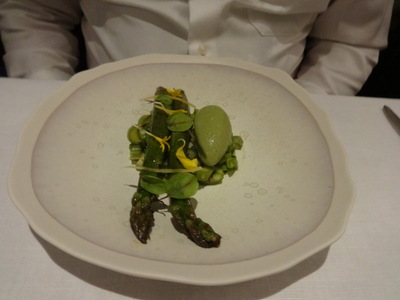
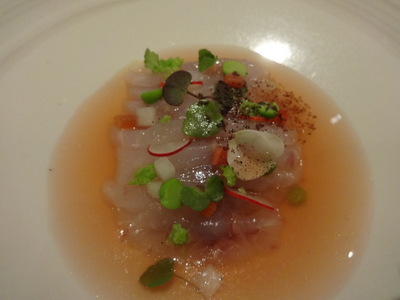 First course, David: green asparagus marinated with green anise (fennel stalks, I think) and accompanied by licorice-verbena sorbet.
First course, David: green asparagus marinated with green anise (fennel stalks, I think) and accompanied by licorice-verbena sorbet.
First course, me: wild bar (Dicentrarchus labrax, European sea bass) marinated and lightly smoked, with rhubarb and raspberry dashi, garnished with peas and radishes. The fish was essentially raw (not a bad thing), and notice that the peas were individually peeled before serving. It was good, but I thought the broth overpowered the fish.
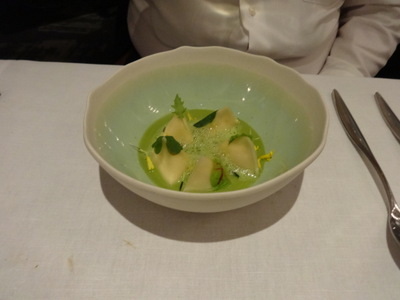
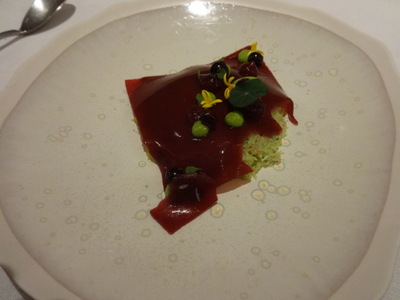 Second course, David: "Berlingots." Berlingots are little pyramidal hard candies (made by pinching a rope of candy dough, then pinching it an inch away at right angles to the first pinch). These were little pyramidal ravioli filled with warm molten Brie, served in a foamy bouillon of zucchini and tarragon. I think that's an Oxalis leaf in there. David loved them.
Second course, David: "Berlingots." Berlingots are little pyramidal hard candies (made by pinching a rope of candy dough, then pinching it an inch away at right angles to the first pinch). These were little pyramidal ravioli filled with warm molten Brie, served in a foamy bouillon of zucchini and tarragon. I think that's an Oxalis leaf in there. David loved them.
Second course, me: At last, a chance to get crabmeat without avocados in it! It was tourteau served with thin slices of a jelly flavored with black currant and elderflowers and bound with a lovage-flavored mayo. Garnished with peas, black currants, little yellow flowers, a nasturdium leave, some tiny sprouts, and not a single Oxalis leaf!
Third course, both: fish. I think we both had the John Dory with a shellfish emulsion, but we ate it before I took a photo.
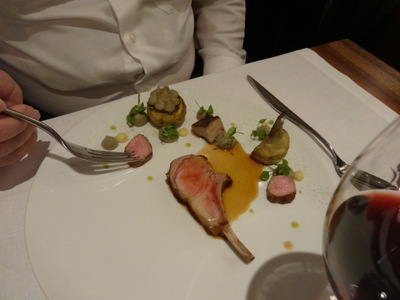
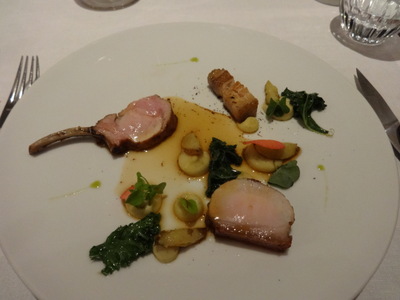 Fourth course, David: baby lamb (a rib chop, chunk of belly, and slices of filet), marinated with Douglas fir and served with peppered artichokes, in the form of a half baby artichoke, a small artichoke heart filled with artichoke purée, and numerous dots and splodges of the purée. No word on what the yellow stuff was, but the weed of choice for garnishing here was "mouron des oiseaux," chickweed.
Fourth course, David: baby lamb (a rib chop, chunk of belly, and slices of filet), marinated with Douglas fir and served with peppered artichokes, in the form of a half baby artichoke, a small artichoke heart filled with artichoke purée, and numerous dots and splodges of the purée. No word on what the yellow stuff was, but the weed of choice for garnishing here was "mouron des oiseaux," chickweed.
Fourth course, me: pork (two different chops and a chunk of belly) marinated in blond beer and camomille (now there's a combination), served with slowly butter poached potatoes (both slices and purée) and sautéed kale. Garnished with nasturtium, chickweed, and Oxalis. Yum.

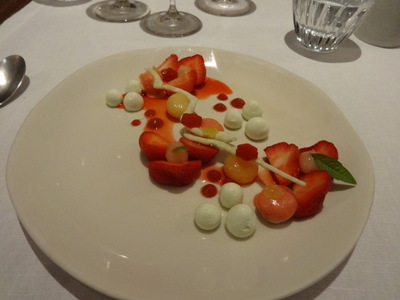 The cheese course was a set assortment: creamy mimolette with saffron, a "fruity" Comté from the Jura, and Stilton "from overseas." A fourth kind, coated with herbs and not described on the menu, lurked under the heap. After reading the menu, I was trying to wrap my head around the concept of "creamy" as applied to mimolette, a pumpkin-colored cheese so brittle it's usually served in fork-broken chunks rather than slices. But they meant it. The bowl behind the plate is filled with a creamy warm preparation of melted mimolette, to be eaten with a spoon. The Stilton and Comté were both great.
The cheese course was a set assortment: creamy mimolette with saffron, a "fruity" Comté from the Jura, and Stilton "from overseas." A fourth kind, coated with herbs and not described on the menu, lurked under the heap. After reading the menu, I was trying to wrap my head around the concept of "creamy" as applied to mimolette, a pumpkin-colored cheese so brittle it's usually served in fork-broken chunks rather than slices. But they meant it. The bowl behind the plate is filled with a creamy warm preparation of melted mimolette, to be eaten with a spoon. The Stilton and Comté were both great.
Dessert, me: "Anaïs" variety strawberries fresh, as sorbet, and as juice with light verbena cream as well as sorbet and conserve of cédrat lemons from Corsica. The leaf is lemon verbena.
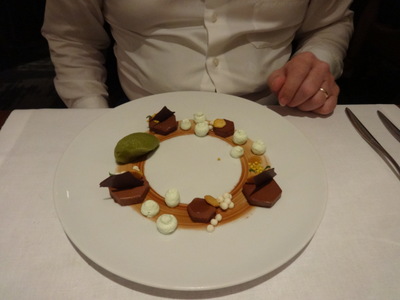 Dessert, David: Chocolate and honey. Creamy "Pic" chocolate from Valrhona with honey from "bruyère cendrée" (Erica cinerea, heath) from the Landes (south of Bordeaux) with green coriander sorbet.
Dessert, David: Chocolate and honey. Creamy "Pic" chocolate from Valrhona with honey from "bruyère cendrée" (Erica cinerea, heath) from the Landes (south of Bordeaux) with green coriander sorbet.
Previous entry
List of Entries
Next entry

 Lunch can be a problem on a Sunday in Paris, because so many places are closed. I did a little poking around on the web to verify that we had a couple of fallback positions if we couldn't find anything near our destination, then we set off bravely to visit the Musée Maillol on the left bank, which displays the work and celebrates the life of Aristide Maillol (1961–1944).
Lunch can be a problem on a Sunday in Paris, because so many places are closed. I did a little poking around on the web to verify that we had a couple of fallback positions if we couldn't find anything near our destination, then we set off bravely to visit the Musée Maillol on the left bank, which displays the work and celebrates the life of Aristide Maillol (1961–1944).
 We like Maillol a lot, and we've already visited his country studio in Banyuls (
We like Maillol a lot, and we've already visited his country studio in Banyuls (
 In his early years, Maillol experimented with painting. At the left is an 1892 "Portrait of Aunt Lucy." At the right is a an 1894 portrait of his wife. I can't say I'm especially taken with his style.
In his early years, Maillol experimented with painting. At the left is an 1892 "Portrait of Aunt Lucy." At the right is a an 1894 portrait of his wife. I can't say I'm especially taken with his style.
 Maillol himself said that he never found his artistic fulfillment in painting but was much happier designing tapestries, like the one at the left here, entitled "The Enchanted Garden.
Maillol himself said that he never found his artistic fulfillment in painting but was much happier designing tapestries, like the one at the left here, entitled "The Enchanted Garden.
 The museum was also hosting a temporary exhibition of the work of Tsugouharu Foujita (1886–1968), about which we knew nothing whatever, so we visited that as well.
The museum was also hosting a temporary exhibition of the work of Tsugouharu Foujita (1886–1968), about which we knew nothing whatever, so we visited that as well.
 At the left here is a 1940 painting (when he was in his 50's) of himself at age 7.
At the left here is a 1940 painting (when he was in his 50's) of himself at age 7.

 Here's his portrait of Suzy Solidor, socialite, independent woman, and sometime singer. Apparently, in those years, everybody had to paint Suzy's portrait—she insisted on it. In Cagnes in 2005, we visited a museum (in the Grimaldi palace) that displayed part of her own collection of portraits of her (though according to the label, she didn't actually commission this one herself).
Here's his portrait of Suzy Solidor, socialite, independent woman, and sometime singer. Apparently, in those years, everybody had to paint Suzy's portrait—she insisted on it. In Cagnes in 2005, we visited a museum (in the Grimaldi palace) that displayed part of her own collection of portraits of her (though according to the label, she didn't actually commission this one herself).
 One of my favorites was this painting of "volubilis" (Ipomaea purpurea, morning glories; gouache and gold leaf on paper).
One of my favorites was this painting of "volubilis" (Ipomaea purpurea, morning glories; gouache and gold leaf on paper).
 For Sunday dinner, David chose La Dame de Pic ("The Queen of Spades"), the restaurant of Anne-Sophie Pic, near the Palais Royal. More dratted "ladies' menus" without prices, as well as having to insist before they would speak French to me, but the food was good.
For Sunday dinner, David chose La Dame de Pic ("The Queen of Spades"), the restaurant of Anne-Sophie Pic, near the Palais Royal. More dratted "ladies' menus" without prices, as well as having to insist before they would speak French to me, but the food was good.
 First course, David: green asparagus marinated with green anise (fennel stalks, I think) and accompanied by licorice-verbena sorbet.
First course, David: green asparagus marinated with green anise (fennel stalks, I think) and accompanied by licorice-verbena sorbet.
 Second course, David: "Berlingots." Berlingots are little pyramidal hard candies (made by pinching a rope of candy dough, then pinching it an inch away at right angles to the first pinch). These were little pyramidal ravioli filled with warm molten Brie, served in a foamy bouillon of zucchini and tarragon. I think that's an Oxalis leaf in there. David loved them.
Second course, David: "Berlingots." Berlingots are little pyramidal hard candies (made by pinching a rope of candy dough, then pinching it an inch away at right angles to the first pinch). These were little pyramidal ravioli filled with warm molten Brie, served in a foamy bouillon of zucchini and tarragon. I think that's an Oxalis leaf in there. David loved them.
 Fourth course, David: baby lamb (a rib chop, chunk of belly, and slices of filet), marinated with Douglas fir and served with peppered artichokes, in the form of a half baby artichoke, a small artichoke heart filled with artichoke purée, and numerous dots and splodges of the purée. No word on what the yellow stuff was, but the weed of choice for garnishing here was "mouron des oiseaux," chickweed.
Fourth course, David: baby lamb (a rib chop, chunk of belly, and slices of filet), marinated with Douglas fir and served with peppered artichokes, in the form of a half baby artichoke, a small artichoke heart filled with artichoke purée, and numerous dots and splodges of the purée. No word on what the yellow stuff was, but the weed of choice for garnishing here was "mouron des oiseaux," chickweed.
 The cheese course was a set assortment: creamy mimolette with saffron, a "fruity" Comté from the Jura, and Stilton "from overseas." A fourth kind, coated with herbs and not described on the menu, lurked under the heap. After reading the menu, I was trying to wrap my head around the concept of "creamy" as applied to mimolette, a pumpkin-colored cheese so brittle it's usually served in fork-broken chunks rather than slices. But they meant it. The bowl behind the plate is filled with a creamy warm preparation of melted mimolette, to be eaten with a spoon. The Stilton and Comté were both great.
The cheese course was a set assortment: creamy mimolette with saffron, a "fruity" Comté from the Jura, and Stilton "from overseas." A fourth kind, coated with herbs and not described on the menu, lurked under the heap. After reading the menu, I was trying to wrap my head around the concept of "creamy" as applied to mimolette, a pumpkin-colored cheese so brittle it's usually served in fork-broken chunks rather than slices. But they meant it. The bowl behind the plate is filled with a creamy warm preparation of melted mimolette, to be eaten with a spoon. The Stilton and Comté were both great. Dessert, David: Chocolate and honey. Creamy "Pic" chocolate from Valrhona with honey from "bruyère cendrée" (Erica cinerea, heath) from the Landes (south of Bordeaux) with green coriander sorbet.
Dessert, David: Chocolate and honey. Creamy "Pic" chocolate from Valrhona with honey from "bruyère cendrée" (Erica cinerea, heath) from the Landes (south of Bordeaux) with green coriander sorbet.